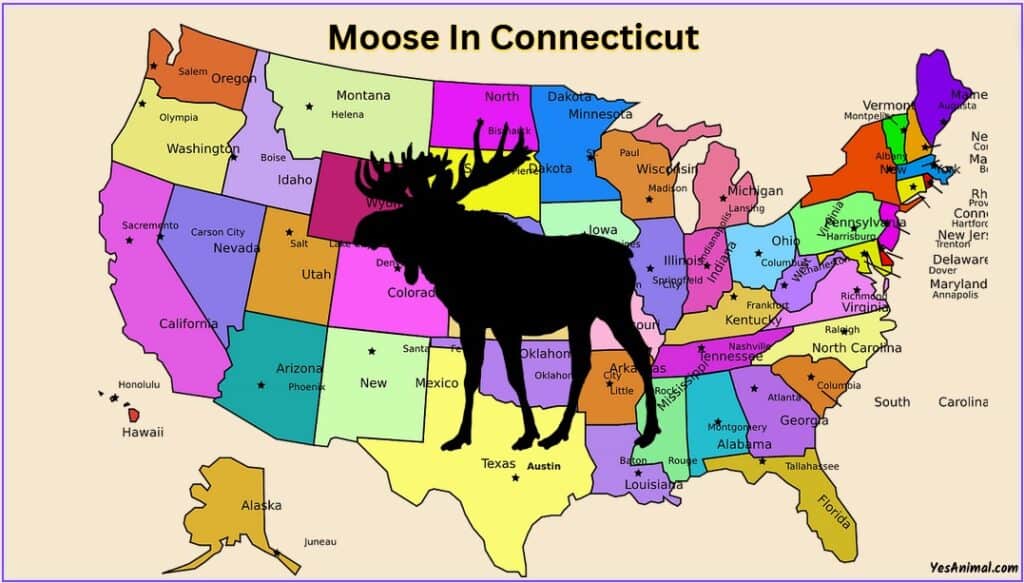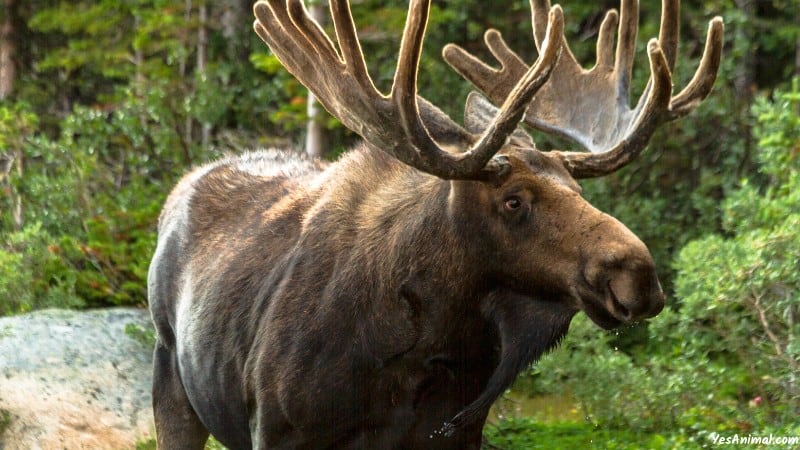Last Updated on September 14, 2023 by Amin Tawar

Are There Moose In Connecticut?
Moose are not native to the state of Connecticut. The first moose sighting in the state was recorded in the 1970s, and a mother with calves was in 2000. This indicated the sign of a resident moose population as they are solitary animals.
The moose has a late start in the state and for acceptable reason. This is because of Connecticut’s climate which is not an ideal habitat for moose. It is too warm, and they do not coexist nicely with people. Small groups can travel south looking for a habitat to stay there.
How Many Moose In Connecticut?
Connecticut does not have the biggest population of moose in the U.S., which added to the surprise moose sightings have lately become a burning topic as most of them are seen all over the state. However, the estimated moose population in Connecticut is said to be only around 100 to 150, which is quite small in number.
Now, within 6 months into 2023, Hartland County has reported about 8 moose spottings and the nearby Windsor has documented about 16 sightings.
The species have been struggling to thrive in the state as the living conditions are not excellent for them. They like cold weather and require a huge supply of greenery, as they consume about 50 to 60 pounds of food every day.
How Big Are Moose In Connecticut?
Moose are big animals with slender, long, grayish legs. They can stand about 6 feet tall at shoulder levels and weigh about 1,400 pounds. Females are a bit smaller when compared to males. On average, a female moose weighs about 750 pounds and male moose weighs about 1,000 pounds.
Both bulls and cows have varying fur colors ranging from blackish-brown to tan. This also depends on the season and age.
Adult males shed their antlers annually and they begin to grow in spring which is fully developed by the end of summer. These antlers can weigh about 60 pounds and are extended to over 5 feet.
What is the moose capital of Connecticut?

Hartland is the “Moose Capital of Connecticut,” as it has the highest amount of moose spottings with 60 reports, in the year 2022. An official from DEEP has stated that moose are mostly found in the Hartland region as the county does a ton of timber administration about the reservoir.
And these animals love the young red maple trees that are present and prevail in those clearings. Further, the Fish and Wildlife Department has mentioned that moose dislike the summer heats, and thus they like to stay near cooling waters and in dense shade.
Also Check Our Guide On Moose In America
Where To See Moose In Connecticut? (Best Time Of Year To See Moose In Connecticut)
You can see the majority of the moose population in Connecticut’s northwestern region. Most moose sightings are documented in Litchfield County, but there has also been plenty of moose seen around the Hartford area, about Windsor Locks.
A few sightings have also been reported of them relaxing in the Connecticut River. There are not many of Connecticut’s southern regions but have been occasionally seen in Danbury. It is also common to spot these animals in both urban and rural areas.
While the Connecticut Department of Energy and Environmental Protection has stated a good amount of them have settled in the forest areas near the Barkhamsted Reservoir. May and June are the best time to see moose in Connecticut as female moose are on the move in search of a new habitat with their younger ones.
Can You Hunt Moose In Connecticut?
Hunting of moose in Connecticut is illegal because of their low population in the state. The only moment when you can lawfully kill a moose in Connecticut is when it is threatening your life. Though moose are not carnivores, they are huge and potentially harmful animals. If you are looking to hunt a moose, then there are a few nearby states which allow you to legally hunt them.
Those states are New Hampshire, Maine, and Vermont. New England also has the finest moose hunting practices in the nation, but, most of these states follow a lottery system when choosing the candidates for hunting, which can be difficult to obtain a hunting permit.
If you are to choose a state, then I would suggest moose hunting in Maine. This is because the state has the highest number of eastern moose populations in the U.S., so there is a very high hunting success rate.
What To Do If You See A Moose In Connecticut?
Usually, moose try to avoid people, but you must still maintain your distance when you spot one. They can become aggressive when they feel that you are a threat. This is particularly true with a bull during its breeding season. Cows are also protective of their small ones as well.
Here are a few tips to keep you safe when you encounter a moose in Connecticut:
- Do not be aggressive or loud, because you do not want the moose to see you as a threat.
- Maintain your distance from the animal.
- When a moose chases you, then run zigzag or try climbing a tree.
Unlike bears, they usually will not chase you when you run. This is your best option if one charges you. When you hold your base, you are seen as a danger. Thus climbing a tree is a good idea.
Apart from these encounters, moose frequently cause problems on the road. You can occasionally spot headlines about them causing harm to vehicles and even accidents. Connecticut has at least 2 moose accidents every year.
And, as they can weigh about 1,500 pounds, a crash at any given speed will generate severe damage to the animal and car. When struck by cars, they break their legs or fall on windshields causing injuries to the passengers in the front row.
Also Check Our guide On Moose In Colorado
Conclusion
And that was everything you need to know about the Moose In Connecticut. I hope this article answered all your queries.
Thank You For Reading!
Our Source For This Guide